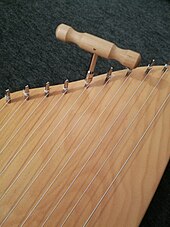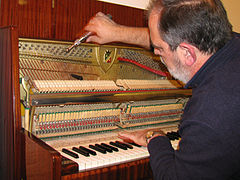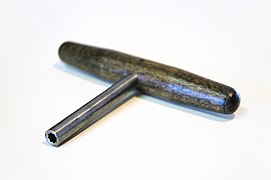Tuning hammer
A tuning hammer , also voice iron , tuning wire or tuning key , is a special wrench for tuning grand pianos , wings , harpsichord , harp , zither , and other stringed instruments , the vortex (also vocal nails called) made of steel and in a pin block are taken.
history
The older term of the tuning hammer originated on the one hand from the shape, which resembles a hammer with the longer handle and the tuning key attached to the side . On the other hand, the hammer head also served to knock in loose or too high up vertebrae. In the case of keyboard instruments , on the one hand, it was common to make your own, precisely fitting tuning hammer for a newly built instrument. On the other hand, the tapering of the square hole inwards was recommended, so that it could still be used for knitting heads of slightly different sizes. A professional tuning hammer had a small hook above the hammer to turn the eyelet or loop that attaches the strings to the suspension pin.
to form
In the L-shape, the tuning hammer consists of a long handle, which is usually made of wood, and a head with the actual ring spanner made of metal. The wrench size must match the tuning pin, which is turned, but has no screw thread, but is driven into the sound post. The ring of the tuning hammer can be square or octagonal. The octagonal shape enables it to be attached to the square vertebra in different positions. The handle of the tuning hammer for the harpsichord is usually shorter, as this is easier to handle and only requires less effort to tighten the string.
Another form of tuning hammer is described as "an iron T-shaped hammer with a square recess in its handle end, with which the pegs of various stringed instruments and. be turned around for the purpose of tuning. ”This shape, which is also called tuning key or tuning crutch, is also found in the sizes that are used for tuning smaller instruments, such as the cantele, children's lyre or gusli, whose strings are shorter and whose Mood therefore requires little effort.
Another shape is found in tuning keys for drums, which are mostly made entirely of metal, have no handle and are much smaller (see picture tuning keys for bongo in the picture gallery.) They are often made of chrome-plated aluminum .
More recently, tuning keys with interchangeable sockets and pull-out handles have also been offered. They are made of steel (including rustproof ), carbon fiber reinforced plastic , aluminum or plastics .
The tuning hammer discussed here is not to be confused with the tuning horn hammer, which is also shaped like a hammer and which is used in organ building with a different function.
use
The tuning hammer or tuning key is placed on the tuning peg of the string to be tuned in order to turn it and to change the string length and thus the pitch . The tighter the string, the higher the sounding tone. The strings are generally wound in such a way that turning to the right tensions the string more and turning to the left decreases the tension. For technical reasons, a string is first relaxed a little and then pulled up to the desired pitch. Special rubber wedges, wooden tweezers or strips of felt are used to prevent the neighboring strings from vibrating when tuning (see picture gallery), especially when the multi-choir strings are close together.
Among the instruments using a voice key must be tuned include all pianos, clavichord , harpsichord, spinet , harp, Veeh harp , zither, dulcimer , lyre , Cantele, psaltery , autoharp , Citera and Gusli . Also timpani and some other tunable percussion instruments are partially tuned using special tuning key. While the tuning of pianos is generally performed by professional piano tuners , it is common for the rest of the instruments for the instrumentalist to tune them himself.
Individual evidence
- ↑ Johannes Ernst Häuser: Musical Lexicon or Explanation and Germanization of the expressions, terms and foreign words occurring in music, with names of the pronunciation, in alphabetical order: an indispensable manual and auxiliary book for music teachers, organists, cantors, as well as for budding musicians. Meissen: Verlag: Goedsche, 1833. Available online: Scan 129 . Retrieved November 6, 2018
- ↑ Gustav Schilling : Encyclopedia of the Entire Musical Sciences or Universal Lexicon of Tonkunst. Stuttgart: Verlag von Franz Heinrich Köhler. 1838. Sixth volume, p. 500
- ↑ Pierer's Universal-Lexikon, Volume 16. Altenburg 1863, p. 837. Online . Retrieved November 6, 2018.
- ↑ Forms and material descriptions at the Hinrichsmeyer tuning hammer manufacture.
- ↑ Example piano parts on Youtube . Retrieved November 6, 2018
- ^ Carl-Johan Forss: Piano and grand piano tuning. Feldgeding: PPV MEDIEN 2007. ISBN 978-3-9378-4135-9
- ↑ Herbert A. Kellner: How do I tune my harpsichord myself? The practice of musical temperatures Feldgeding: PPC Medicine 1986. ISBN 3-923-63968-6







